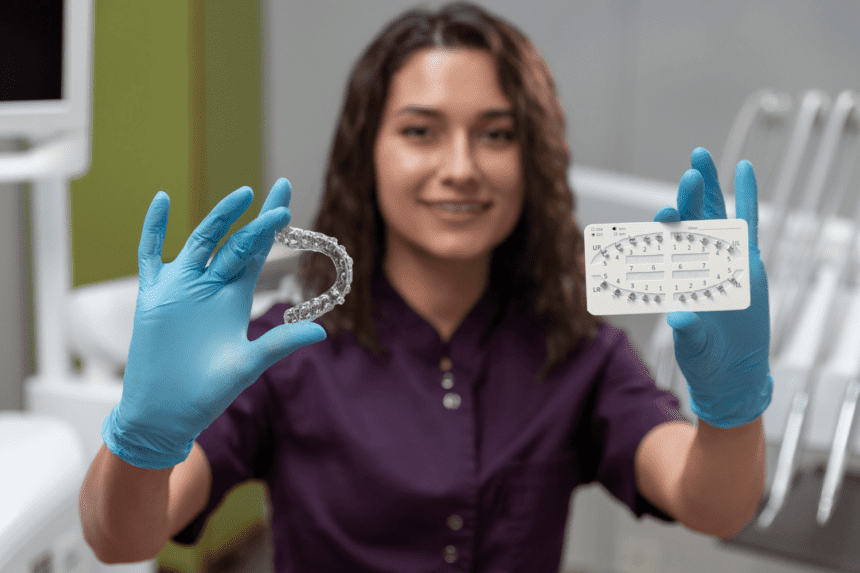Invisalign and braces are common orthodontic treatments for straightening misaligned teeth and enhancing the look of a smile. The decision is based on severity, affordability, and lifestyle.
We will look into Braces vs. Invisalign and understand the differences between them.
What is Invisalign?
Invisalign therapy uses transparent, plastic aligners. Each patient’s aligners are custom-made after a 3D scan of their mouth. Customized teeth aligners are then created to reposition the teeth in tiny increments until the right position is achieved.
The Benefits of Invisalign
1. Invisalign seems better.
Invisalign is a popular alternative because of its almost invisible retainers, which are liked by both adult patients and self-conscious teenagers because they are not visible to coworkers or clients throughout orthodontic treatment.
2. Always brush and floss your teeth
In addition to eating and drinking, you will need to remove your Invisalign retainers to wash your teeth. With nothing on your teeth to worry about, you may continue cleaning and flossing as usual.
3. Less dependency on orthodontists
Invisalign creates customized retainers in a laboratory based on a 3D scan of the teeth, decreasing the need for regular orthodontic appointments. Multiple sets of retainers are replaced per the orthodontist’s directions, resulting in less time off work.
4. Comfortable for daily use
Invisalign is a more comfortable alternative to traditional braces, as it uses special plastic retainers to fit each patient’s mouth, reducing mouth and gum problems. Unlike traditional braces, Invisalign retainers do not cause cuts or salt washes on the inside cheeks.
Challenges of Invisalign
Patients using Invisalign require removing aligners after eating or cleaning, which can be uncomfortable for a few people and costly. Some may need lingual braces for undetectable results.
What are Braces?
Braces were originally formed of metal and fastened to the outside of the teeth, however, there are many types of braces like ceramic braces, colored braces, and lingual (behind the teeth) braces. Metal wires and elastic bands are linked to the brackets to move your teeth and address issues orthodontically.
The Benefits of Braces
1. Suitable for all treatments
Braces are an effective treatment approach that may repair a variety of dental and facial disorders with anchors and arch wires, resulting in a stunning smile.
2. It is possible to accomplish a perfect result
Braces for teeth provide better outcomes than Invisalign because they provide more force for tooth movement, whereas Invisalign has a restricted movement capability.
3. Several types of braces to pick from
Patients can now opt for lingual and ceramic braces, which have a less obvious appearance and provide the same power as metal braces.
4. Quick treatment
Braces typically provide faster treatment times for tooth alignment because they close gaps and align teeth more quickly. The pace of treatment, as well as the competence of a professional orthodontist, help to achieve faster outcomes.
Challenges of Braces
Traditional braces can cause social self-consciousness, making brushing and flossing difficult. Good oral hygiene is essential to avoid plaque formation. Patients must follow orthodontist instructions. Careful diet and food preparation are essential for braces. Regular check-ups are needed to monitor progress and adjust braces. Invisalign patients need bi-monthly surgery.
Braces vs Invisalign
An orthodontist can help you decide which orthodontic treatment is most beneficial to you. They can assess your situation and propose the best solution for your requirements. We have listed below some important points in braces vs Invisalign, so that you can take the right decision:
1. Duration of Treatment
Depending on the degree of the misalignment, Invisalign treatment takes 12 to 18 months, whereas braces can take 18 to 24 months, and in some cases, it can take more than 2 years, to resolve severe disorders.
2. Comfort and Look
Unlike traditional metal braces, which require frequent tightening and pain because of their more obvious appearance, Invisalign aligners are smooth plastic, nearly undetectable, and pleasant for keeping a natural look during orthodontic treatment.
3. Procedure for Cleaning and Maintenance
Regular care and teeth cleaning are crucial for Invisalign and braces. Invisalign requires brushing after meals and removing aligners before eating or drinking. Traditional braces require daily flossing and using a special device to reach between brackets and wires. Do not eat hard or sticky foods to prevent damage to the braces. Both methods require good oral hygiene for optimal results.
4. Convenience
Instead of dealing with the inconvenience of conventional braces, Invisalign is a removable option for correcting crowded teeth. Compared to traditional braces, they require fewer clinic visits, and patients may remove them for different kinds of activities. However, because it necessitates more regular trips to the dentist’s office, it could be problematic for people with hectic schedules.
5. Procedure
The process for braces and Invisalign is different. With Invisalign, a dentist’s 3D model of the patient’s teeth is utilized to create personalized aligners. Dentists generally suggest that aligners be worn for 20 to 22 hours per day for two weeks. Before adjusting the brackets and wires, a dental X-ray is needed to define the course of therapy for braces.
Conclusion
Braces vs Invisalign has concluded that both Invisalign and braces are excellent teeth-straightening options, with each having its own set of benefits and problems. Invisalign is chosen for its comfort, inconspicuous look, and flexibility, whereas braces are preferred for their efficacy in addressing severe misalignments. The choice between the two should be determined in collaboration with an orthodontist, taking into account treatment time, comfort, cost, and personal lifestyle choices.


Leave a Reply